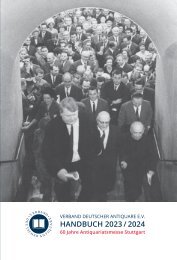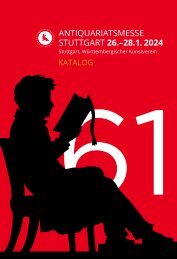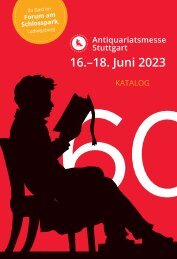Antiquariatsmesse Stuttgart 2022 - Katalog
Katalog zur Antiquariatsmesse Stuttgart 2022: Die diesjährige Antiquariatsmesse Stuttgart, Deutschlands bedeutendste Messe für schöne und seltene Bücher, Autographen, illustrierte Werke und Graphik findet, wie bereits im vergangenen Jahr pandemiebedingt nicht als klassische Messe, sondern in Form des gedruckten Kataloges und als digitale Messe auf bewährter Plattform (18. bis 22. Februar 2022) statt. 73 Antiquariate und Galerien aus Deutschland, Österreich und der Schweiz, den Niederlanden, Frankreich, England und den USA werden auch in diesem Jahr die gesamte Bandbreite des Antiquariatshandels präsentieren. Der gedruckte Katalog wird ab dem 31. Januar 2022 an interessierte Kunden verschickt, die virtuelle Messe öffnet ihre „digitalen Pforten“ am 18. Februar 2022 um 12.00 Uhr unter www.antiquariatsmesse-stuttgart.de
Katalog zur Antiquariatsmesse Stuttgart 2022: Die diesjährige Antiquariatsmesse Stuttgart, Deutschlands bedeutendste Messe für schöne und seltene Bücher, Autographen, illustrierte Werke und Graphik findet, wie bereits im vergangenen Jahr pandemiebedingt nicht als klassische Messe, sondern in Form des gedruckten Kataloges und als digitale Messe auf bewährter Plattform (18. bis 22. Februar 2022) statt.
73 Antiquariate und Galerien aus Deutschland, Österreich und der Schweiz, den Niederlanden, Frankreich, England und den USA werden auch in diesem Jahr die gesamte Bandbreite des Antiquariatshandels präsentieren.
Der gedruckte Katalog wird ab dem 31. Januar 2022 an interessierte Kunden verschickt, die virtuelle Messe öffnet ihre „digitalen Pforten“ am 18. Februar 2022 um 12.00 Uhr unter www.antiquariatsmesse-stuttgart.de
Erfolgreiche ePaper selbst erstellen
Machen Sie aus Ihren PDF Publikationen ein blätterbares Flipbook mit unserer einzigartigen Google optimierten e-Paper Software.
Pocket version of Abraham Ortelius’ (1527–1598) celebrate<br />
“Epitome”, a reduced format of his famous<br />
“Theatrum Orbis Terrarum” (1570), which marked an<br />
epoch in the history of cartography. This probably is<br />
the 2nd valuable edition in Latin, the 1st Latin edition<br />
was published in 1585 with fewer maps. Philippe Galle<br />
(1537–1612) was a friend and collaborator of Ortelius.<br />
In 1577, he suggested producing this small format<br />
pocket-book edition of the “Theatrum”, the “Epitome”,<br />
which he also helped to finance. It was originally<br />
published from 1577 up to 1602 in several languages for<br />
the use of students or travellers. This present pocket<br />
atlas includes a. o., Ortelius’ famous world map “Typus<br />
Orbis Terrarum”, (f. 1), the “India and China” maps on<br />
ff. 100 & 101 show also Japan, some other maps related<br />
to both Americas (ff. 1, 4, 5, 97, 101). – Adams O-345;<br />
Phillips 402; Koeman (Ort) 56; JCB I, 595/51; cf. Sabin<br />
57690. – See illustration.<br />
red morocco, gilt lettering on spines (somewhat<br />
faded), gilt outer and inner fillets, all edges gilt.<br />
From the library of James Arthur Taylor with his<br />
engr. bookplate. Paris, De l’Imprimerie des Frères<br />
Mame & Chez Antoine-Augustin Renouard, 1808–<br />
16. € 2100,–<br />
Collected works by Voltaire (1694–1778), illustrated<br />
with a suite of engravings, mostly done by J.-M. Moreau<br />
le jeune (1741–1814). Single copies from the present<br />
edition were also sold separately by Renouard.<br />
“Cette collection de gravures est l’une des plus belles<br />
qui ait jamais été exécutée pour aucun livre” (Fürstenberg).<br />
– Bengesco IV, 2184; Quérard, La France<br />
littéraire X, 378–379; Bocher, Catalogue de l’oeuvre,<br />
pp. 582 & 618; Sander, Illustr. franz. Bücher, 1407; cf.<br />
Cohen/de Ricci 1047; cf. Lewine, p. 566; no copy in<br />
BnF. – See illustration.<br />
Le Parnasse contemporain, recueil de vers nouveaux<br />
3 vols. (all published). Ed. by Louis-Xavier<br />
de Richard and Catulle Mendès. With title-vign.<br />
and numerous head- and endpieces. 2 ff., 284, (2)<br />
ff.; 2 ff., 401 pp.; 2 ff., 451 pp. 4to (c. 255 × 165 mm).<br />
19th century half cloth, backs with gilt lettering,<br />
orig. wrappers bound in. Paris, Alphonse Lemerre,<br />
(1866–1869–1876). € 5250,–<br />
First edition of the “Parnasse contemporain”, a rare and<br />
complete set of the first (1866), second (1869) and third<br />
(1876) series (all), in which the work of more than a<br />
hundred French poets appeared, mostly previously unpublished.<br />
The first volume contains “Les Èpaves” and<br />
“Nouvelles Fleures du Mal” by Charles Baudelaire, and<br />
early Mallarmé and Verlaine, avante-garde poets of its<br />
time. Authors are a. o. Banville, Cros, Villiers, Gautier<br />
and Anatole France. The influence of the Parnassians<br />
was felt throughout Europe and was particulary evident<br />
in the Modernist movement of Spain and Portugal<br />
and in the “Jeune Belgique” (Young Belgiums). Many<br />
former Parnassians became part of the Symbolist movement<br />
in the late 19th century.<br />
Voltaire, (François-Marie Arouet de). (Oeuvres<br />
choisies). Edition stéréotype d’Herhan. 21 vols.<br />
With 178 engraved plates, mostly by Moreau le<br />
Jeune. 8vo (c. 210 × 140 mm). Late 19th century full<br />
Vredeman de Vries, Hans (or Jan). Perspective Id<br />
est, Celeberrima ars inspicientis aut transpicientis<br />
oculorum aciei, in pariete, tabula aut tele depicta<br />
… 2 vols. in 1. Two printed titles with elaborate<br />
engr. architectural borders, woodcut initials, 1 (of<br />
2) engr. portrait in the text and 49 engr. plates in<br />
vol. 1 (33 + 34 on 1 leaf), and 24 engr. plates in vol.<br />
2. Text printed in 2 cols. 9 (of 10) unn. leaves; 3 unn.<br />
leaves. Oblong folio (280 × 350 mm). 17th cent.<br />
marbled boards (new endpapers). Leiden, Henricus<br />
Hondius, 1604–1605. € 5200,–<br />
First edition of H. Vredeman’s (1527–1604) “Perspective”<br />
issued by H. Hondius the Elder (1573–1650)<br />
and printed simultaneously also in French, Dutch and<br />
German. Present here is the valuable Latin version,<br />
“the classical language in which Vredeman’s architecture<br />
is clad and thus becomes timeless in its character”<br />
(Millard, p. 20f.). This is one of the most celebrated<br />
and major works on such a subject. The two volumes<br />
illustrate stage perspective, interiors, furniture, palace<br />
and garden architecture. This copy has the same collation<br />
as the Fowler copy at Johns Hopkins University<br />
library which also lacks at the beginning of vol. 1 the<br />
leaf A1v with an engraved portrait on left half and a<br />
printed poem on right half of this leaf. The only copy<br />
in Switzerland in the holdings of the ETH-Library in<br />
Zurich is also incomplete and a mixed-up one (1st part<br />
in Latin, 2nd part in French). Other incomplete copies<br />
are known in the holdings of the Bavarian State Library<br />
Munich, the V & A Mus. London, the Pierpont Morgan<br />
Library New York. – Cf. Cicognara 867 (French ed.);<br />
Millard, Northern European Books, 139 (lacking engr.<br />
title to part II); Berlin Cat. 4704; Fowler 432 (same<br />
collation); cf. Nagler I, 1757; Borggrefe, Heiner. Hans<br />
Vredeman (2002).<br />
165






